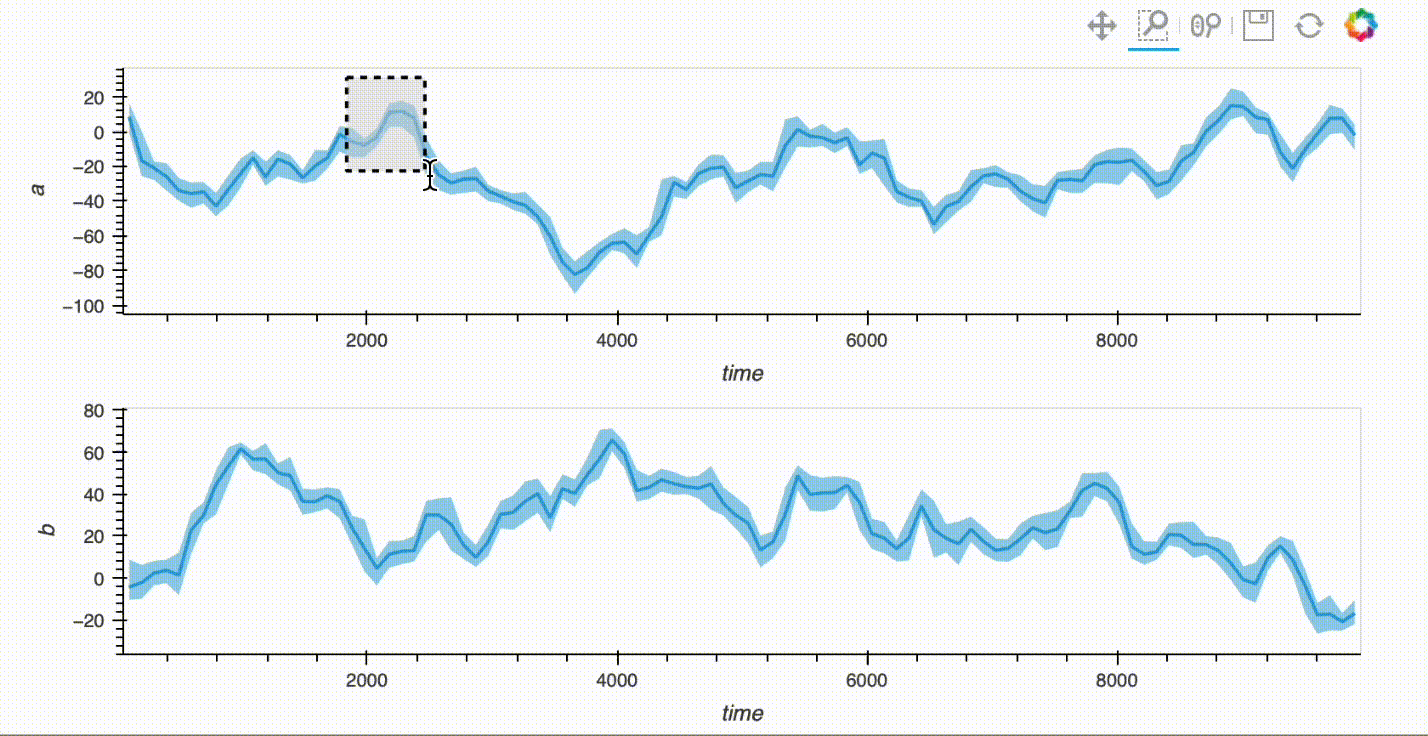I can have the streams of two DynamicMaps (say dmap1 and dmap2) share the single source, and this source can be one of the dmaps, say dmap1. So, fiddling with dmap1 reflects both dmap1 and dmap2. Is there a way to make this behavior symmetric, so that in addition, when I fiddle with dmap2 it also updates dmap1?
MWE
import numpy as np
import holoviews as hv
hv.extension('bokeh')
from holoviews.streams import RangeX
# create some dummy data
X = np.random.randn(2,10000).cumsum(1)
# function that creates dummy hvElement
# fwiw, in real case I am combining an Image with a Curve
def get_curve(x_range, x, Npoints=100, vdim="_"):
'''Shows only around 100 points per range together with the curve's envelope.
If the range is such that the number of data points is smaller than Npoints,
show them all.
'''
t0, t1 = x_range
t_span = t1-t0
tt = np.arange(
max(int(t0),0),
min(int(t1)+1,x.size)
)
xx = x[tt]
nrebin = int(tt.size//Npoints)
cs = []
if nrebin>1:
tr = tt[:tt.size//nrebin*nrebin].reshape((-1,nrebin))
xr = xx[:xx.size//nrebin*nrebin].reshape((-1,nrebin))
cs += [hv.Curve((np.mean(tr,axis=1),np.mean(xr,axis=1)),
kdims=["time"], vdims=[vdim])]
cs += [hv.Area((np.mean(tr,axis=1),np.max(xr,axis=1),np.min(xr,axis=1)),
kdims=["time"],
vdims=[vdim,vdim+"_"],
).opts(alpha= .5,line_width=0)]
else:
cs = [hv.Curve((tt,xx), kdims=["time"], vdims=[vdim])]
return hv.Overlay(cs).opts(width=800, height=200)
# test the function is need
# get_curve((0,X.shape[1]),X[0])
# get_curve((0,X.shape[1]/100),X[0])
# construct dynamic maps
xrange = RangeX(x_range=(0,X.shape[1]))
dmap1 = hv.DynamicMap(lambda x_range: get_curve(x_range,X[0],vdim='a'), streams=[xrange])
dmap2 = hv.DynamicMap(lambda x_range: get_curve(x_range,X[1],vdim='b'), streams=[xrange])
(dmap1+dmap2).cols(1)

I’ve tried having separate streams, and combining them post creation, but unsurprisingly this led to a clash on x_range's.
xrange1 = RangeX(x_range=(0,X.shape[1]))
xrange2 = RangeX(x_range=(0,X.shape[1]))
dmap1 = hv.DynamicMap(lambda x_range: get_curve(x_range,X[0],vdim='a'), streams=[xrange1])
dmap2 = hv.DynamicMap(lambda x_range: get_curve(x_range,X[1],vdim='b'), streams=[xrange2])
dmap1.streams += [xrange2]
dmap2.streams += [xrange1]
hv.Layout([dmap1,dmap2]).cols(1)
# output:
# Exception: The supplied stream objects RangeX(x_range=(0, 10000)) and
# RangeX(x_range=(0, 10000)) clash on the following parameters: ['x_range']`